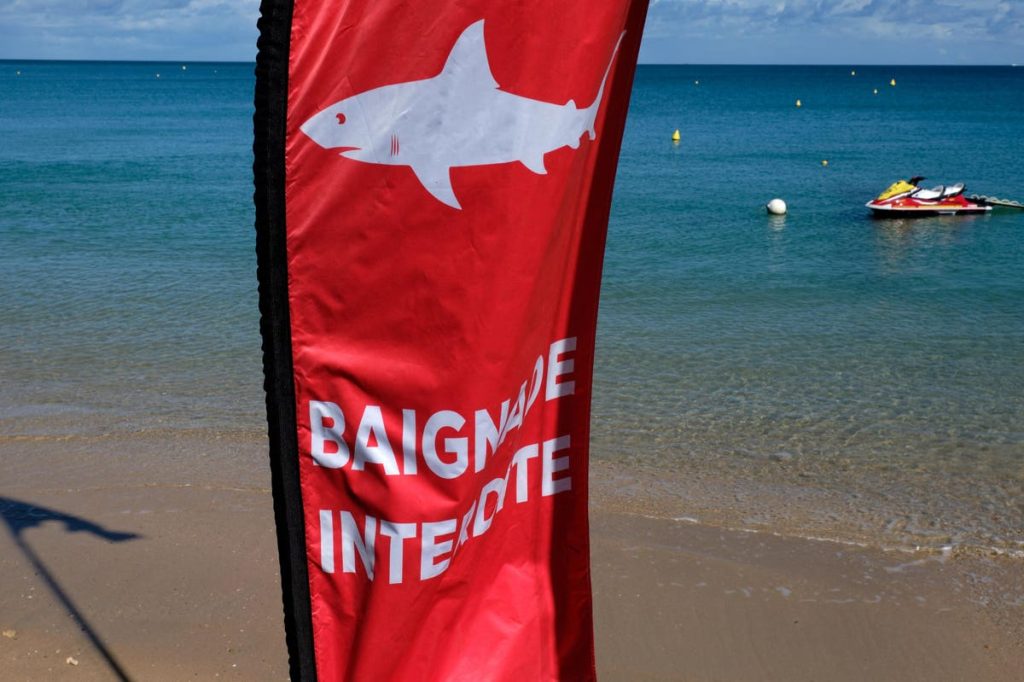In the tranquil waters of Nouméa’s beaches, Aline Guémas takes a deep breath in before she immerses herself in the vibrant underwater world. A remarkable blend of natural beauty, unique biodiversity, and cultural significance, this turquoise seascape is teeming with an incredible variety of marine life. From pristine white sandy beaches to rugged cliffs, it’s a picturesque backdrop for locals and visitors alike.
And as a member of a snorkeling group at the picturesque Baie des Citrons beach, Guémas has marveled at the life beneath these waves for years. “It has exceptional biodiversity, almost half of the species present in New Caledonia inhabit its coral reef,” shares 65-year-old Guémas. “Some endangered species come to reproduce here like the zebra shark.”
Yet, the calm serenity has been interrupted by a string of shark bites (three in less than a month), prompting restricted access to parts of the beach for months. These encounters, including a tragic fatality involving an Australian tourist, have led to officials discussing a controversial plan for a shark net. They believe it’s the only way to keep residents safe… but these measures have been met with resistance from scientists, environmental groups, and many locals.
Guémas asserts, “People who usually frequent these waters know this [is not the answer] and do not want any shark net to be installed,” says Guémas.
The capital city of New Caledonia, a French overseas territory located in the South Pacific Ocean, Nouméa is situated on the main island of Grande Terre. The city’s picturesque landscapes, vibrant culture, and proximity to stunning natural attractions attract tourists seeking outdoor adventures, water sports, and relaxation on beautiful beaches. And officials worry the sharks will scare tourists away, not to mention keep harming locals. And while encounters with sharks have risen in New Caledonia (the country ranks 13th in the world for the number of attacks), scientists say research, not killing, is the answer.
A controversial practice, culling began earlier this year in response to the bites. Nouméa’s mayor Sonia Lagarde of Nouméa states that there was an “overpopulation problem” and “that we need to get rid of a certain number of [sharks]” as a justification for the cull. Yet Dr. Johann Mourier, a shark scientist and behavioral ecologist, believes this isn’t the answer: “Culling campaigns rarely work, they only serve to appease the population because of the emotion surrounding shark incidents.” The culls are due to run until December, according to the Nouméa town hall. The culling initiative is set to continue until December, according to of public records, and has resulted in the killing of at least 68 sharks thus far. However, these actions have faced sharp criticism from environmental organizations like the International Union for Conservation of Nature, given that the culled species, bull and tiger sharks, are also vulnerable and were removed from local protection lists.
The government also intends to establish a 758-meter metal net at Baie des Citrons, serving as an underwater barrier to deter sharks from approaching the shore. A popular beach and recreational area located in Nouméa, Baie des Citrons is renowned for its stunning coastline, clear blue waters, and vibrant atmosphere. Shark nets are physical barriers made of mesh that are placed in the water close to shorelines to create a barrier between sharks and swimmers. The idea is to prevent sharks from entering designated swimming areas. However, shark nets can also inadvertently trap and kill other marine life. While some scientists, including Mourier, view the proposed shark net as a more favorable option than culling, concerns linger about its impact on biodiversity. An assessment commissioned by local authorities revealed that the net could harm coral reefs and inadvertently entangle non-target species like turtles and leopard sharks. Many believe that potential alternatives like drone surveillance and smart drumlines offer more sustainable solutions, having been tested in similar contexts like Australia. For now, the net’s installation is slated for completion by October.
Alexandre Henri, a Nouméa resident, agrees that while the nets might “reassure” swimmers, people are worried about the impact on marine life: “I want there to be a place where we know it is safe. The net will reassure people so I am in favour of the idea. But I still wonder if fish will get stuck in it or how it will impact the environment.”
But one question remains unanswered: why did so many bites happen in such amount of time? Mourier notes that these patterns tend to be cyclical, “with a lot of consecutive biting incidents and then nothing for several years.” The complex causes behind these negative encounters remain a mystery to scientists, with factors ranging from shifts in prey availability to human-induced factors like feeding practices and sewage discharges attracting sharks closer to the coast. While many crave for a single answer as to why sharks bite, there rarely is just one.
As Nouméa grapples with finding a harmonious coexistence between its residents both on and off land, the delicate balance between safeguarding lives and protecting biodiversity remains an ongoing endeavor.
Read the full article here









